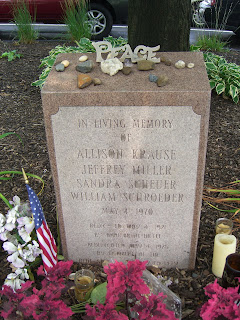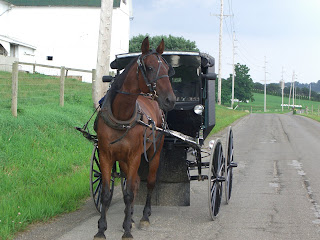
 Hello from Ohio where I'm spending time with Yuko! I was ready to leave Turkey, but I must admit that it was indeed a little sad to depart. I'm glad to be back in the States, though. This is my second to last blog posting; when I get to California I will compose a final reflection on this summer's learning experiences. In the meantime, I thought I'd share more "Americana," since that's how this blog begins; I thought you'd like to see a couple of the things I've seen these past few days here in Ohio, starting with a beautiful thistle that we encountered on the way to the farmer's market near Yuko's house. Doesn't it look just like the one in Turkey? I photographed it on a cloudy rainy day (it's been pouring pouring every afternoon!), so the color is not as vibrant as the one in Turkey. And then there are all these beautiful red berries blooming everywhere.
Hello from Ohio where I'm spending time with Yuko! I was ready to leave Turkey, but I must admit that it was indeed a little sad to depart. I'm glad to be back in the States, though. This is my second to last blog posting; when I get to California I will compose a final reflection on this summer's learning experiences. In the meantime, I thought I'd share more "Americana," since that's how this blog begins; I thought you'd like to see a couple of the things I've seen these past few days here in Ohio, starting with a beautiful thistle that we encountered on the way to the farmer's market near Yuko's house. Doesn't it look just like the one in Turkey? I photographed it on a cloudy rainy day (it's been pouring pouring every afternoon!), so the color is not as vibrant as the one in Turkey. And then there are all these beautiful red berries blooming everywhere. 
 *****
*****The other day, Yuko and I went to see the memorial near her office at Kent State University. No matter how many times I visit, it's a moving site, but now, given what's going on in Iraq and Afghanistan, and given the lack of true activism in the States, this memorial is particularly relevant. Aside from the four marked actual spaces where the students where shot dead, a short distance up the hill there are four granite casket-like sculptures (reminiscent of the Vietnam Memorial in DC), and an Ohio Historical Society plaque with these words:

May 4, 1970
In 1968, Richard Nixon won the presidency partly based on a promise to end the Vietnam War. Though the war seemed to be winding down, on April 30, 1970, Nixon announced the invasion of Cambodia, triggering protests across college campuses. On Friday, May 1, an anti-war rally was held on the Commons at Kent State University. Protestors called for another rally to be held on Monday, May 4. Disturbances in downtown Kent that night caused city officials to ask Governor James Rhodes to send the Ohio National Guard to maintain order. Troops put on alert Saturday afternoon were called to campus Saturday evening after an ROTC building was set on fire. Sunday morning in a press conference that was broadcast to the troops on campus, Rhodes vowed to "eradicate the problem" of protests at Kent State. On May 4, 1970, Kent State students protested on the Commons against the invasion of Cambodia and the presence of the Ohio National Guard called to campus to quell demonstrations. Guardsmen advanced, driving students past Taylor Hall. A small group of protesters taunted the Guard from the Prentice Hall parking lot. The Guard marched back to the Pagoda, where members of Company A, 145th Infantry, and Troop G, 107th Armored Cavalry, turned and fired 67 shots during thirteen seconds. Four students were killed--Allison Krause, Jeffrey Miller, Sandra Scheuer, and William Schroeder. Nine students were wounded--Alan Canfora, John Cleary, Thomas Grace, Dean Kahler, Joseph Lewish, D. Scott MacKenzie, James Russell, Robert Stamps, and Douglas Wrentmore. Those shot were 20 to 245 yards from the Guard. The Report of the President's Commission on Campus Unrest concluded that the shootings were "unnecessary, unwarranted, and inexcusable."
I will add that none of the Guard who shot the students were prosecuted or penalized in any way whatsoever.
 Another day, Yuko and I went to the world's largest Amish community in Holmes County in the middle of Ohio, mainly the towns called Millersburg, Berlin, and Walnut Creek. There we enjoyed the beautiful pastoral scenery, drove by many farms with corn and soy beans growing lushly, ate a hearty homemade lunch, shopped for hand-made quilts and furniture, and actually drove after one of the many buggies that clip-clop along at snail's pace while cars zoom by them. Once we caught up with the unsuspecting buggy, I got out of the car to ask if I could take a picture. The only "driver," a woman, said sure--as long as I left her out of it. I did; the picture is above.
Another day, Yuko and I went to the world's largest Amish community in Holmes County in the middle of Ohio, mainly the towns called Millersburg, Berlin, and Walnut Creek. There we enjoyed the beautiful pastoral scenery, drove by many farms with corn and soy beans growing lushly, ate a hearty homemade lunch, shopped for hand-made quilts and furniture, and actually drove after one of the many buggies that clip-clop along at snail's pace while cars zoom by them. Once we caught up with the unsuspecting buggy, I got out of the car to ask if I could take a picture. The only "driver," a woman, said sure--as long as I left her out of it. I did; the picture is above. Of the 267,000 acres in Holmes County, 172,000 are farmed. What amazes me (and the reason I ran after buggies so I could capture their image) is the fact that since the 1900s the Amish community has fought so hard to stay the same and still be relevant. That's a huge challenge! But they've managed to retain their values, lifestyle and identity and yet remain economically viable; most no longer farm and have opted to become furniture manufacturers.
Of the 267,000 acres in Holmes County, 172,000 are farmed. What amazes me (and the reason I ran after buggies so I could capture their image) is the fact that since the 1900s the Amish community has fought so hard to stay the same and still be relevant. That's a huge challenge! But they've managed to retain their values, lifestyle and identity and yet remain economically viable; most no longer farm and have opted to become furniture manufacturers. 
And... having just returned from Turkey, a Muslim country where very few women cover their heads, and living in the States where stereotypes about Muslim women's scarves are wild and rampant, it's fascinating to me to walk among Amish women. They never cut their hair, and typically wear it in a braid or a bun on the back of their heads. Like the Jewish Orthodox women I have met in Brooklyn and in the Catskills of New York, Amish women must always conceal their hair with a small white cap called a "Covering." An Amish woman can never be seen outside her home without her Covering.

The Amish in the United States are direct descendents of a 16th century European religious sect called Anabaptists. They challenged the reforms made by Martin Luther during the Protestant Reformation, mainly rejecting baptism early in infancy and favoring baptism in adulthood once able to make a conscious decision to be Christian. They were one of the first groups to insist on separating church and state. One of their first leaders was the Dutch Anabaptist Menno Simons (who lived between 1496 and 1561), and that is why the community also became known as Mennonite. When their religion began to be persecuted, the the Amish/Mennonites fled to Switzerland and other remote parts of Europe. In the 1600s a large sub-group led by Jakob Ammann broke from the larger Swiss community, because they disagreed over the strict enforcement of Meidung (which means shunning, that is, excommunicating members who don't follow rules), the practice of foot washing and the wearing of particular dress. That group that broke away is the group that then fled to the United States and settled mostly in Ohio.

The first sizeable group of Amish arrived in America around 1730 and settled near Lancaster County, Pennsylvania. They also settled throughout twenty-four other states, in Canada and in Central America, but about 80% located in Pennsylvania, Ohio and Indiana. The greatest concentration of Amish people is in Holmes and adjoining counties in northeast Ohio. Next in size is a group of Amish people in Elkhart and surrounding counties in northeastern Indiana. Then comes the Amish settlement in Lancaster County, Pennsylvania.

Today, the Amish population in the United States is more than 150,000 and it is still growing; they have large families, seven children on average. Up until the early 1900s the Amish were no different from others, but in an effort to follow their founder, Jacob Amman, they began to resist change. To me, the Amish are indeed fascinating because they're clearly a reminder of how Americans used to be, and of how "minorities" can be successful--albeit marginal--components in American society.
 I will end this blog entry on a happy note by showing you my dear friend's watercolors. Yuko shares my need to learn and my wanderlust; those are two of the many reasons we've been close friends for over 20 years. In this first watercolor she's depicted Dragor in Denmark, which she visited just last year. And in the second watercolor she's shown Fredericksberg Park in Copenhagen.
I will end this blog entry on a happy note by showing you my dear friend's watercolors. Yuko shares my need to learn and my wanderlust; those are two of the many reasons we've been close friends for over 20 years. In this first watercolor she's depicted Dragor in Denmark, which she visited just last year. And in the second watercolor she's shown Fredericksberg Park in Copenhagen. 

No comments:
Post a Comment